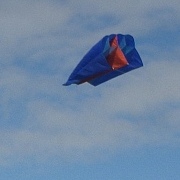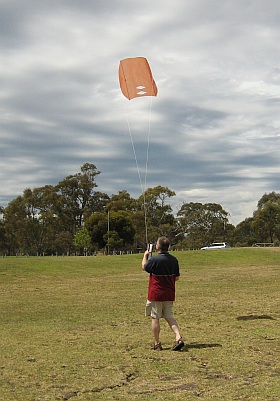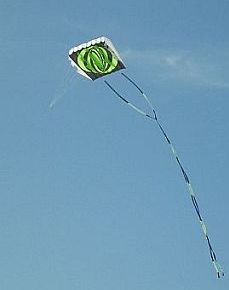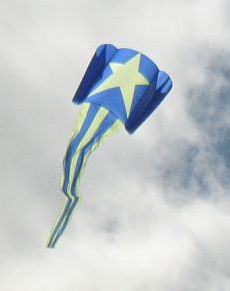- Home Page
- Kiddy Kites
- Easy Kites
Easy Kites
Single-Line Parafoils or Sleds!
When it comes to easy kites to fly, they don't get much easier than single-line parafoil kites or sleds! You just hook the line on and fly. They're easy to transport as well, as both these kinds of kites can be made completely "soft."
 MBK Parafoil
MBK ParafoilThe main feature of a parafoil sail is that it has a top and bottom surface, divided into cells.
These cells are closed at the back. So as the kite flies, the cells
fill with air from the front and keep the kite semi-rigid. It doesn't
need straight sticks to keep its shape.
The great thing about this is that the whole kite packs down into a very small space! These are easy kites to take anywhere on any form of transport.
If the kite is small enough, it will even cram into a pocket! Of course, you need some flying line as well, but that can be quite compact too.
On this site, there's more kite-making info than you can poke a stick at. :-)
Want to know the most convenient way of using it all?
The Big MBK E-book Bundle is a collection of downloads—printable PDF files which provide step-by-step instructions for many kites large and small.
Every kite in every MBK series.
 MBK Dowel Sled
MBK Dowel SledA sled sail has just a single surface, but two spars help to
keep the kite's shape as it flies. See that homemade job in the photo
over there, with wooden dowel spars.
Now, we are talking about easy kites here, so what could be even easier to handle than a sled kite with two sticks for spars? A sled with inflatable spars...
In these designs, a tapered pocket runs from top to bottom of the kite, one on each side. The pocket is open at the front and closed, or at least a lot smaller, at the back. Like a parafoil cell, these pockets inflate when the kite is flying and act like rigid spars.
This is a ram-air sled and like the parafoil is completely "soft." Guess what you can do with the popular Pocket Sled (scrunch it up and stick it in your...).
Super Easy Kites to Set Up!
Setting up is a breeze, since both these single-line designs just need to have a flying line attached before they are ready to go. A Lark's Head knot is the easiest way to quickly attach and remove a flying line. Often, clear simple instructions for this knot are included on the packaging of the kite when it is sold. That was the case when we bought a Baby Sled for our toddler, years ago.
For a well-designed parafoil or sled, tails are not necessary. Some small ones have tails, anyway, since they add a bit of color and spectacle while in the air. For larger kites, tails can actually be a bit of a nuisance on the ground in windy weather, blowing around and getting tangled and caught up on things.
It's very easy to connect and disconnect tails with a simple clip or tie, if provided. The smallest kites tend to come with simple tails permanently attached.
If you love the idea of long, colorful tails streaming back in the breeze, go for it! We've seen parafoils and sleds of all descriptions sporting long, flowing tails. Usually, there are twin tails on sleds but anywhere from one to several streaming behind a big parafoil.
Tubular tails are popular on the bigger kites. They're just like a long but skinny windsock!
For even more of an eye-catching display, you can't go past rotating tails that windmill around in the breeze. Maybe try two of them, rotating in opposite directions!
I hope you enjoy the two photos below that we took at a kite festival here in Adelaide, South Australia:
 Flat single-line parafoil
Flat single-line parafoil A "soft" sled
A "soft" sledThe parafoil on the left is quite a large kite, with no less than five keels! It's not for kiddies, that one. The sled on the right is not as big but is still big enough to require an adult flier. These were registered kites, owned by experienced fliers. The general public were flying much smaller kites, including some single-line parafoils and sleds, on the other side of the jetty.
If you ever go to a kite festival, you will see plenty of examples of these two basic types of kites. You might also notice that there are quite a few variations on the basic design.
For example, some of the bigger sleds have three ram-air spar pockets
instead of two. If the pockets are big, they might even have a dividing
wall down the middle, splitting the spar pocket itself into two cells.
As for parafoils, some of the bigger ones can have quite a number of keels and bridle lines. But remember, there is just one attachment point for the flying line, with nothing else to adjust!
I hope you have enjoyed this short introduction to some easy kites that could give you and your family something different to do next weekend!
As mentioned earlier, there's more kite making on this site than you can poke a stick at. :-)
Want to know the most convenient way of using it all?
The Big MBK E-book Bundle is a collection of downloads—printable PDF files that provide step-by-step instructions for many kites large and small.
That's every kite in every MBK series.
